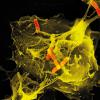Professor Douglas Young discusses the last 40 years of tuberculosis research, as he hangs up his lab coat for the final time.

Ask Professor Douglas Young what inspired him to focus on tuberculosis over the course of his career, and he answers: “I had initially felt it was embarrassing that people should still be dying from a simple bacterial infection, that this just reflected selfish neglect on the part of countries with developed economies, and that the problem would be resolved by some basic appliance of science.”
As he began to understand more, he adds, he felt that the idea of simple bacterial infections cured by antibiotics was misleading. The complexity of the tuberculosis infection itself highlights the underappreciation of the interdependence of humans and microbes, Douglas says.
A third of the global population is exposed to infection with mycobacterium tuberculosis, but only 10% will actually develop the disease. Whether a person develops tuberculosis or whether the bacteria stay in the body without ever causing any symptoms is the result of complex interactions between the bacteria and the body’s immune system.
Evolution
Douglas is retiring from a 40-year research career (his most recent role was Head of the Division of Mycobacterial Research at the Francis Crick Institute) with an interest in studying the ways mycobacterium tuberculosis has co-evolved with humans over the last 70,000 years.
“My efforts to understand a single bacterium underwent serial expansions into questions of human physiology, evolution and society, all of which kept me interested,” he says. “I continue to be surprised by the fact that all isolates of M. tuberculosis can be traced back to a single bacterial clone in the not-so-distant past.
I also continue to be surprised by the fact that I am unable to say with certainty whether the not-so-distant past is about ten thousand years ago or about a hundred thousand years ago. I favour the latter.”
Humans have genome sequences from very close relatives of M. tuberculosis and genome sequences from M. tuberculosis isolates that have evolved in different populations, he explains. Genetic variation comes down to a seemingly manageable number of mutations, but it’s not yet obvious which ones actually make the difference.
M. tuberculosis does not demonstrate the horizontal acquisitions of defined “virulence factors” that are reflected in the pathogenesis of some well-characterised bacteria, he adds. “The success of M. tuberculosis must lie in some more subtle combination of host-pathogen interactions that eludes our current comprehension.”
All about Douglas
- Graduated in 1978 with a DPhil in microbial enzymology from the University of Oxford.
- Followed that with two post-doctoral fellowships, one at the Foundation for Medical Research in Mumbai, India, and one at the London School of Hygiene and Tropical Medicine
- Spent eight years as a career scientist in the MRC Tuberculosis and Related Infections Unit in London
- From 2007, headed the Division of Mycobacterial Research at the MRC’s National Institute for Medical Research in London, one of the parent institutes that became the Francis Crick Institute in 2015
- Helped establish two research centres at Imperial College London
- Led a $20m international project funded by the Bill & Melinda Gates Foundation and Wellcome, which aims to develop new drugs for the treatment of latent tuberculosis.
Challenges
Not being able to fully answer the question of how tuberculosis has evolved with humans, and “facing the fact that 90% of what you do on a daily basis ends up going absolutely nowhere, and that the progress you do achieve appears in retrospect to be minimal in comparison to the new questions it opens up, is a bit tough”, Douglas says, and something he tackled during this career by “having a few drinks with colleagues”.
He has seen funding into tuberculosis increase –“albeit by orders of magnitude less than HIV” – so earlier cries that progress was stymied by neglect and rock-bottom funding became difficult to support. “We had to admit that it’s a lack of knowledge and insight that’s at issue.”
Advances
Yet more consistent progress has been made in drug discovery and cell biology, with new imaging technologies allowing “remarkably detailed insight” into host-pathogen interactions.
Douglas’ research into leprosy, undertaken during his post-doctoral fellowship at the Foundation for Medical Research in Mumbai, has also influenced understanding of tuberculosis. He worked on a glycolipid antigen of mycobacterium leprae – the leprosy-causing bacteria which is related to M. tuberculosis, and which is refractory to laboratory culture and study by microbiology.
“This provided a useful way into the microbiology and immunology of mycobacteria,” he adds. “Leprosy research was really exciting in the late ‘70s and early ‘80s. This was right at the very start of the genomics revolution and we could see how access to mycobacterial DNA would provide an exciting new way to explore the biology of leprosy.”
In the late ‘80s, cellular immunology advances – including cloning of the T cell receptor – were thought to provide an understanding of immunity and point the way to a vaccine design, Douglas says.
“However, although we have accumulated lots more T cell subsets and cytokines, it doesn’t really add up to a clear understanding. Perhaps we should be thinking about immunology more as a means of maintaining homeostasis, rather than as a battleground?”
Future direction
Like all biology, he says, tuberculosis research has been overwhelmed by host and bacterial genomics, initially in a gene-by-gene reductionist mode, now focused on a more holistic understanding.
“With a significant tuberculosis research effort in the Crick Institute, I envisage that problems in understanding and control of tuberculosis will be addressed in the broad context of human biology and evolution, rather than as a disease speciality,” Douglas adds.
He would like to see future research approaches “reach an understanding with microbes, rather than just trying to kill them off”, especially because M. tuberculosis demonstrates how a microbe is able to straddle the boundary between harmless commensal and deadly pathogen.
“I wonder if we shouldn’t be trying to renegotiate some form of ‘microbial contract’ in light of antimicrobial resistance and appreciation of the pervasive influence of the microbiome,” Douglas says.
A legacy
According to his peers from all over the globe, Douglas has played a major role in initiating research on disease progression that underpins current approaches to development of new drugs and vaccines for tuberculosis, shown scientific insight, leadership and influence, and clearly articulated scientific challenges with a clarity of insight and engaging writing style.
But ask him what he’s most proud of about his career and he says: “The fact that I survived from one end of it to the other.”




